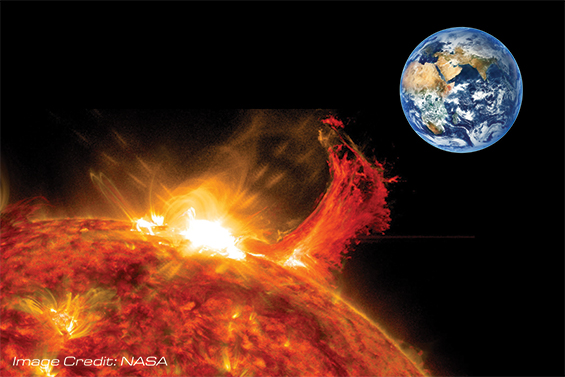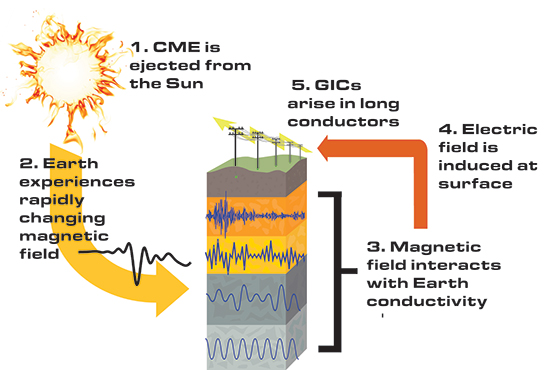Geomagnetic disturbances (GMDs), often called geomagnetic storms, and geomagnetically induced currents (GICs), are gaining recognition as a threat to the bulk power system. GICs are the currents that are induced in long conductors during GMD events. This phenomenon occurs with every geomagnetic storm, large and small. GICs can damage system assets in a manner that can be sudden and catastrophic, as in the case the Quebec storm of 1989. The impact of GICs can also be chronic, quietly aging assets during the moderate events that occur on a regular basis. In this article, we will talk about what causes GICs and the science behind the hazard.
Solar impacts on Earth
The ‘solar wind’ is a continuous stream of particles emanating from the sun. It is a plasma, a gas of charged particles. The solar wind is composed mostly of protons and electrons. Its associated electric and magnetic fields move outward from the Sun along with it. Irregular disturbances on the sun cause bursts of the solar wind that are of higher intensity than normal. A geomagnetic storm occurs on the Earth when a disturbance on the Sun affects the Earth through the solar wind.
The solar disturbances with greatest impact on the earth are masses of ejected particles and electromagnetic fields called Coronal Mass Ejections (CMEs). Large CMEs can travel at speeds close to 2000 km/s and are many times the size of the Earth. Unlike the normal solar wind, CMEs do not emanate more or less uniformly in all directions. Each one is a huge bolus (or blob) thrown out from the sun in a particular direction. Sometimes, a CME strikes the earth.

A coronal mass ejection (CME) from the surface of the Sun.
(NASA artist’s composite)
When a CME strikes the Earth, a chain reaction of events occurs. The Earth’s magnetic field, which provides a natural shield against the fast-moving plasma, is compressed, sometimes drastically. Electric currents that exist in the ionosphere are enhanced and new ones are formed. Charged particles travel down the magnetic field lines in the Polar Regions, producing the visual manifestation of a geomagnetic storm that we know as the aurora. During very large events, the electric current systems that cause the aurora are pushed very far southward in the Northern Hemisphere and the aurora can be seen unusually far from the north polar regions.
On the ground, the effect of this complicated interaction is a rapidly changing geomagnetic field. Whenever there is a changing magnetic field, an associated electric field is induced. Engineers know this principle as Faraday’s Law. It is this geoelectric field, induced by the rapid change in the geomagnetic field near the surface, that causes GICs to arise in long conductors on the surface of the Earth.
The ‘climatology’ of geomagnetic storms
The Sun goes through a quasi-predictable pattern of activity called the solar cycle, which is typically about 11 years long. A greater number of geomagnetic storms are expected during the maximum of the solar cycle and in its declining phase. However, large storms can happen at any time in the cycle.
To provide a simple index of the strength of geomagnetic storms, the National Oceanic and Atmospheric Administration’s Space Weather Prediction Center has defined a geomagnetic storm scale, similar to the manner in which hurricane and other atmospheric storm scales have been devised. (See http://www.swpc.noaa.gov/noaa-scales-explanation.)
Moderate storms (G2 on NOAA’s Geomagnetic Storm Scale) occur, on average, on about 360 days out of every solar cycle, or about nine percent of the time. Strong (G3) and severe (G4) storms, occur on average about 130 and 60 days per solar cycle, respectively, or about three percent and one percent of the time.
Extreme events (G5 on the NOAA scale) are much less common. On average, there are 4 occurrences of G5 geomagnetic storms per solar cycle, which is about 0.1 percent of the time.
Even among these events, only a few are large enough to be catastrophic in terms of GIC impact. There have been several storms of this magnitude observed in the past 200 years of recorded magnetic history, including the Carrington Event of 1859. The Carrington Event, occurring in the infancy of the electric industrial age, interrupted railroad service in much of the United States for several days, as it made telegraphy between stations, on which train signaling depended, difficult or impossible. Other extreme events include the event of May 1921, during which telegraph equipment and undersea cables were damaged and telegraphy interrupted in some parts of both Europe and North America; the 1989 event that caused the Quebec blackout; and the 2003 ‘Halloween’ event that caused significant and persistent damage in the South African bulk power system.
We are fortunate that these events are relatively rare. The past 20 years have been unusually quiet in terms of geomagnetic activity. However, as we become more dependent on an aging and increasingly saturated power system, the potential risk of significant impact continues to increase. The 1921 event, and in particular the 1859 event, would have been very destructive if they had occurred in our present advanced state of infrastructure development and great dependence on electric power and telecommunications equipment.
The role of deep Earth conductivity
As stated above, conditions favorable to GICs are created by a rapidly changing geomagnetic field. GMD events are typically of continental scale, due to the large scale of the upper atmospheric electric current systems that drive them, although there can be ‘hotspots’ at smaller scales. However, the induced geoelectric field is very dependent on location. The reason for the smaller horizontal scale of variability of the geoelectric field, compared to the GMDs that drive it, is that the geoelectric fields at the surface are due to interaction of the GMDs with the conductivity of deep earth structures. The horizontal scales of variability of these deep earth structures cover the range from sub-continental to local, in contrast to the fully continental scale of the GMDs.
In addition to the effect of location on the Earth’s surface, the induced geoelectric field also depends on the frequency content of the geomagnetic disturbance. This is due to an effect known as the ‘skin depth’ of the conductor, where longer-period fluctuations penetrate more deeply into the Earth. Therefore, different frequency components of the geomagnetic field will interact most strongly with different layers of the Earth. As a result, a single GMD event can induce very different electric fields at two locations due to their having very different conductivity structures beneath them. Conversely, two different storms of similar strength but with different frequency content can induce very different electric fields at the identical location.
A one-dimensional (1-D), or layer cake model, is a simple first-order approach to modeling earth conductivity. For the United States, the U.S. Geological Survey has developed a set of 1-D models, based on similar efforts in Canada and the U.K. Nineteen models cover the contiguous United States, with an additional five models covering parts of Alaska. Each model refers to an irregularly shaped region; the boundaries between the model regions are based on geological and geophysical considerations. The models descend to a depth of 1000 km in the Earth. These models can reproduce the observed electric field response in many cases. They successfully capture the ‘frequency vs depth’ aspect of modeling the geoelectric field. They are often used in broad-scale hazard modeling and ‘big picture’ analysis of GIC hazards.

The chain of events from a coronal mass ejection (CME) on the Sun
to geomagnetically induced currents (GICs) in transmission lines
Unfortunately, real-world conductivity structures are rarely one-dimensional. Abrupt changes in conductivity, for example, at a coastline, or at an interface between two rock structures of different composition, cause the 1-D models to break down. Where a large change in conductivity occurs, large enhancements in the induced electric field may be observed.
Because of the natural complexity of earth conductivity and geomagnetic storms, geoelectric field conditions are highly variable in location and time. Often, geoelectric fields peak during the largest fluctuations, such as at the beginning of a storm, but high frequency components at later times during the storm can also have a large impact.
Major hazard and risk factors for GICs
It is important to understand the difference between hazard and risk. Technical definitions exist for both. However, it is probably easiest to understand the difference by analogy to the more familiar topic of earthquake hazard and risk. The earthquake hazard for a particular location is a statistical description of the probabilities of the different kinds and strengths of ground motion. The earthquake risk, however, depends on the particular circumstances of the person or infrastructure that is exposed to the hazard. For example, a person in a building is exposed to greater earthquake risk than is the same person in a neighboring open field, although the natural hazard is the same in both cases.
A weak two-story house built of bricks is at greater risk than a neighboring single-story wood frame house, though the natural hazard is the same. The earthquake risk to a person or an asset results from the interaction of the natural hazard with the vulnerabilities of the person or asset.
In a similar manner, the induced geoelectric field is the natural hazard for GICs, while the GIC risk to a particular utility system is (informally speaking) the danger of loss or damage to that system, based on that system’s response to the geoelectric field. Damaging currents are more likely to occur in certain power system configurations than in others.
In assessing the potential for GIC damage to a particular system, the following are some of the hazard and risk factors that must be considered:
Magnetic latitude is a generally well-understood hazard factor for GIC. The ionospheric electric current systems that are enhanced or created during GMD events are typically fairly far north. For infrastructure that is on or near the ground, the more nearly it is beneath these current systems, the more it will be exposed to the influence of a geomagnetic storm. For the most part then, more northern locations will have greater GIC hazard. However, during a GMD event, the southern boundary of this complex of current systems expands and moves away from the north polar region. Although these effects are reasonably well understood and modeled, it is unknown how far from the pole these ionospheric current systems can move during the most extreme events.
Deep earth conductivity has a large impact on GIC hazard, as discussed above. In general, regions with more complicated geological structure have greater hazard because of localized enhancements of the geoelectric field. This includes coastal regions, due to the large difference in conductivity between the water and the land. Also, because the induced geoelectric field depends on the how the solid earth responds to the frequency content of the geomagnetic storm, some regions may be more reactive to GMD events with high frequency (rapid) magnetic field fluctuations, but may not be sensitive to low frequency (slow) variations. In some other regions the response will be the opposite. The vertical and horizontal variation in the earth conductivity thus leads to a geoelectric field hazard that depends both on location and on the frequency spectrum of the particular storm.
System characteristics contribute critically to risk factors. The length and orientation of a transmission line with respect to the geoelectric field largely determine the magnitude of the resulting GICs. Longer lines and lines that are parallel to the geoelectric field will have larger GICs. During a large storm, the orientation of the magnetic field fluctuations due to the storm may vary wildly from moment to moment. The fluctuations do not have a directional preference, which means that conducting lines in all orientations are potentially at risk during different time segments of a GMD event. System owners and operators have no control over the GIC hazard, but can reduce GIC risk through appropriate engineering and operations measures.
Resources for GIC hazard and risk analysis
Although GIC hazard and risk analysis can be complex, there are many good tools and new resources to assist in assessing risk. These include:
Extensive sources of geophysical and magnetic field data exist, that can be used for local analyses. Government, academic and commercial data resources are growing rapidly.
Several of the currently available, off-the-shelf software packages that are used to model power systems now include GIC modules. These GIC modules take a user-prescribed geoelectric field as input, so the user can calculate the system’s GIC response to a given geoelectric field.
Electric field models, based on geophysical analysis of deep earth conductivity and surface magnetic fields, are available to calculate time-varying geoelectric fields. These calculations may be based either on hypothetical or actual geomagnetic events. The calculated fields may be fed into the GIC modules of the power system software for analysis of a system’s GIC response to various electric field scenarios.
Existing geophysical data can be augmented by new low-cost field studies. Using local information can significantly increase the accuracy of local geoelectric modeling.
Real-time geomagnetic fluctuation sensors and near-real time application of electric field models can provide situational awareness for operations. Sensors and models each have their capabilities and limitations, but together they can help inform you of the local conditions during a storm. This knowledge can be important for making informed operational decisions.
Summary
GICs in long power lines occur due to the induced near-surface geoelectric field during a GMD event. This induced near-surface electric field results from the changing geomagnetic field as it interacts with the deep earth. The inductive response of the deep earth varies, due to the spatial variation of deep earth conductivities. The magnitude of the geoelectric field therefore varies greatly with location and also over the evolution of a GMD event. These GMD-induced geoelectric fields constitute the natural hazard that drives GIC risk. The risk to a particular power system depends on how it responds to this natural hazard. Certain system configurations are more susceptible to damage during a GMD event than others. As our understanding of the nature of GMDs and how they drive potential damage from GICs improves, so do the tools and resources that are available. Earth conductivity models, geoelectric models, local magnetic field measurements and power system modeling software are all tools that can be used to analyze and monitor GMDs and GICs, and to assist in protecting power systems from them.
About the Author
 Jennifer L. Gannon has been studying charged particles and electromagnetic phenomena in near-earth space and the solid earth throughout her scientific career. Jenn served as a scientist at the NOAA Space Environment Center and its successor agency, the NOAA Space Weather Prediction Center, and later as a Federal researcher at the U.S. Geological Survey. Moving to the private sector, Jenn cofounded Space Hazards Applications, LLC, of Boulder, Colorado, a consulting firm for space hazards to built infrastructure. Jenn is the author or co-author of many publications in the peer-reviewed literature, as well as several U.S.G.S. Open-file Reports and conference presentations. Jenn received her Ph.D. degree at the University of Colorado Laboratory for Atmospheric and Space Physics in 2006. She currently serves in CPI’s Boulder office as Geomagnetic Disturbance Division Lead. You can reach Jenn at gannon@cpi.com or 303-442-3992.
Jennifer L. Gannon has been studying charged particles and electromagnetic phenomena in near-earth space and the solid earth throughout her scientific career. Jenn served as a scientist at the NOAA Space Environment Center and its successor agency, the NOAA Space Weather Prediction Center, and later as a Federal researcher at the U.S. Geological Survey. Moving to the private sector, Jenn cofounded Space Hazards Applications, LLC, of Boulder, Colorado, a consulting firm for space hazards to built infrastructure. Jenn is the author or co-author of many publications in the peer-reviewed literature, as well as several U.S.G.S. Open-file Reports and conference presentations. Jenn received her Ph.D. degree at the University of Colorado Laboratory for Atmospheric and Space Physics in 2006. She currently serves in CPI’s Boulder office as Geomagnetic Disturbance Division Lead. You can reach Jenn at gannon@cpi.com or 303-442-3992.









